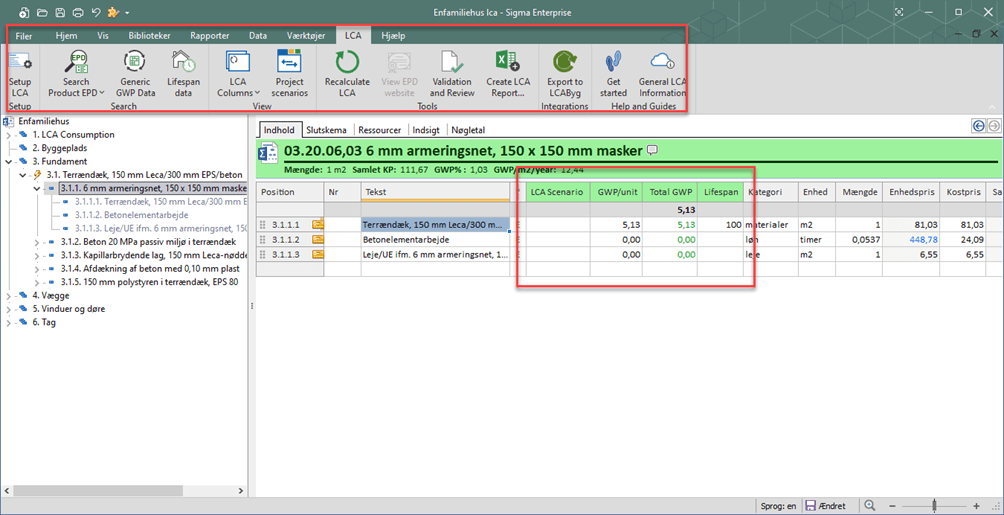
Mandatory new requirements for sustainable construction
LCA – a concept that is suddenly everywhere. What is it and what does it mean for you?
Here, we give you a clear and simple overview, and useful advice on how to make working with it easy. LCA needn’t be difficult and unmanageable – it’s primarily about understanding it and knowing your options.
The reason for all of this is that carbon emissions from buildings and construction are way too high. From 1 January 2023, a new law has been adopted that sets out requirements for all parties in the construction industry.
So now you know. But if you’d like to understand what LCA is, what the requirements mean for you and how you can make it easy to work with, then stay put.
LCA in 1 minute
LCA is a life cycle assessment of a building. In other words, how the construction, operation and dismantling of the building impact the environment. The primary focus is currently on global warming, but in a few years, we may well be required to assess other factors, such as acidification, poisons, etc.
Global warming is essentially caused by carbon emissions. However, other gases such as methane are also driving climate change. GWP (Global Warming Potential) is a blanket term used to quantify what is emitted, but converted to “kg CO2eq/kg”. So, if, for example, 1 kg of methane is emitted, it will be converted to 80 kg CO2eq/kg. The task is therefore to be able to calculate and document GWP – i.e. what is emitted from gases that increase global warming (GWP), converted to CO2eq.
To make it easy to compare buildings, it is calculated as kilograms of CO2 per square metre per year.
The new law
On 1 January 2023, an addendum to the Danish Building Regulations came into force, stipulating that a life cycle assessment must be conducted on all new buildings to calculate their environmental impact. A maximum GWP threshold of 12 kg CO2 equivalent per square metre per year must also be documented on buildings larger than 1,000 m2.
The lifespan of the building is set at 50 years (although it will probably last longer), and a check must be made of whether the lifespan of all materials is less than 50 years. This is because replacements also have an environmental impact. However, not all building parts must be included in the calculation. Virtually everything to do with plumbing and electrical work is exempt, for example. The intention is that the law will be continuously revised, and that the requirement of around 12 kg, for example, will be lowered in the future.
How is it calculated?
Let it be said right away that conducting an LCA is no easy task. Unless you use a good tool, that is.
Because it basically boils down to an assessment of how much carbon went into procuring raw materials, transporting them to the factory, processing them and making the final building material for every sheet of plasterboard, every brick, every piece of corrugated board, etc. The environmental impact of the disposal of said material must also be assessed.
It might sound like an insurmountable task, but fortunately, help is at hand!
Most suppliers of materials have been working on this for many years and are ready to provide information and figures for their products that indicate how much CO2 is emitted in connection with the manufacturing and disposal of the materials. And just as there are product sheets providing dimensions, assembly instructions, etc., there are now EPDs for materials that list GWP values. EPD is, moreover, an abbreviation of Environmental Product Declaration, i.e. a data sheet that communicates the impact of the material on the environment. Fortunately, most of these EPDs have been digitised to allow computer programs to import the figures automatically.
In addition to this, the new law contains a table of typical building materials and estimated GWP values that may be used in the assessment.
So your job is basically to:
- Find out what building parts (plaster walls, ceilings, windows, etc.) are included in the construction and in what quantities
- Find out what GWP values exist for these building components (by either looking at EPDs or the tables in the Building Regulations)
- Estimate the annual energy consumption of the building (probably already done by a consultant when designing the building)
- Add it all up, and divide by the size of the building and the period you are looking at (50 years)
Solutions and tools
A number of solutions have already been developed. Aalborg University has, for example, developed a program that shows the principles of how the calculation can be made (called LCAbyg). Others have tried to create solutions in BIM programs (e.g. Revit) which can facilitate the task.
At EG Construction, we’ve chosen to do things a little differently!
We decided to use the calculations we make when working out the price of a building (calculation) as an obvious starting point. This way, it can all be done in one go.
When calculating the price of a building, we have to break down the building into building parts, and find quantities and unit prices. Now, we just need to know the CO2 emissions of each building part. Then we have our calculation.

We’ve developed an extension of the calculation programs that makes it easy to import CO2 information (EPDs) directly into the programs, and extended them to calculate GWP based on lifespans, building size and other information. This way, we can show how the building is performing in relation to the LCA requirements. And with built-in reporting functions, documentation is easy with figures, graphs, and lists referencing data source.
The overall benefits for you are:
- Continuous calculation of the environmental and economic performance throughout the project
- Search in EPD data from Danish and European databases
- Search in generic GWP values from BR18 legislation
- Creation of own CO2 libraries to ensure that all knowledge is reused
- Simulation of scenarios for the project’s environmental and economic performance